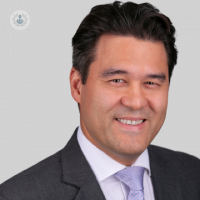Should I have a revision facelift?
Escrito por:If you have had a facelift and are unsatisfied with the outcome, you may choose to have a revision facelift, a secondary procedure that aims to revise and restore the results of the first facial operation.
Mr Juling Ong, highly esteemed consultant craniofacial, cosmetic and paediatric plastic surgeon, provides an expert insight into a revision facelift, including why might it be needed and how long should you wait before having it.

What is a revision facelift?
As we age, a number of changes occur in the face which we associate with getting old. These changes are different in different people but, often, the most obvious ones are changes in the quality and texture of the skin and a general drooping of facial tissues with gravity. Complex changes in the shape of the bones are happening here under the skin, as well as alterations in the volume and distribution of the natural pockets of fat, and the stretching of the ligaments that support the soft tissues of the face.
When I perform a facelift, I try to understand the contributions of each of these tissue factors and address them by surgery.
Thus, a revision facelift is a surgical procedure which is performed after a previous facial surgery. A patient may want a second procedure if they feel that they have lost some of the benefits of their previous rejuvenating surgery over time, or perhaps earlier, if patients have not achieved the results that they were expecting.
Why might someone need a revision facelift?
Although a facelift is a powerful technique to address some of the changes that we see in ageing, it does not necessarily stop the process of ageing. So over time, it is inevitable that the changes in the skin, fat and bone will continue to progress and this may result in a patient considering a second procedure to rejuvenate the face.
It is also not just the ageing process which alters the shape of the face and many patients will have had non-surgical and surgical rejuvenation procedures such as fillers or fat grafting. Although these interventions can have really good results, it is important to consider them when planning a second facelift.
Some patients that come to me have had previous interventions and have been unhappy with the shape, volume or scarring from the previous treatment. A revision surgery is almost always more complicated. It will take longer and you have to be much more careful navigating through areas which have been previously operated on. The challenge is to achieve a natural result by understanding how the tissues have healed after the previous surgeries and encouraging them to heal in a way which is soft, natural and young.
What happens during a revision facelift?
This very much depends on what has been performed before and how the tissues of the face have healed. I spend a long time speaking with my patients to understand what they like and dislike about their face. This may take a number of appointments, but I think it is important to understand the nuances of the perception of their appearance, so that when it comes to the actual surgery, I have an idea of the challenges in the tissues that I may encounter as well as a surgical plan to address the changes in appearance that we have worked together on in the consultations.
How long should you wait to get a revision facelift?
This really depends on the reason for the revision facelift but, in general, the longer between surgeries the better. Tissues take almost two years to settle down after an injury and although the majority of this healing happens within the first few months, I would recommend waiting at least a year before any further surgery is considered.
Although a revision facelift is always going to be more complicated, I think it is more likely that a patient will get a more predictable result with fewer risks the longer the time between surgeries.
Who can perform a revision facelift?
If you are considering a revision facelift, you should seek a surgeon who has extensive experience in facial operations. They should be comfortable safely navigating through the tissues of the face and have a deep understanding of how the tissues will respond to tension and how they will heal. They should also be aware of the variety of potential implants, fillers and procedures that have been performed before and the potential problems that these may cause.
Finally, they should be able to give you the time and consideration to fully analyse your face to understand your aesthetic goals. There is no single look that works well on everyone and your surgeon should be able to understand what you have in mind to be able to help you achieve that.
Mr Juling Ong is a highly esteemed consultant craniofacial, cosmetic and paediatric plastic surgeon who specialises in cosmetic and reconstructive procedures. If you’re considering a facelift and wish to explore your options, don’t hesitate to visit Mr Ong’s Top Doctors profile today.


